The 2014 Razer Blade Review
by Brett Howse on October 10, 2014 9:00 AM EST- Posted in
- Notebooks
- Gaming
- Laptops
- Razer Blade
System Performance
The Razer Blade continues to utilize the Intel Core i7-4702HQ CPU due to the timing of the launch. There are a couple of different choices at this time (i.e. i7-4710HQ) that were not around when the Razer Blade was refreshed. Compared to an Ultrabook, the Razer Blade is a full quad-core part with eight threads, so performance should be significantly better than the Haswell U series parts, but of course that is at the expense of power consumption, with the i7-4702HQ CPU rated at 37 watts. Coupled to this is an SSD in the Samsung PM851 and 8GB of DDR3L-1600 memory, which should provide excellent performance for day to day tasks.
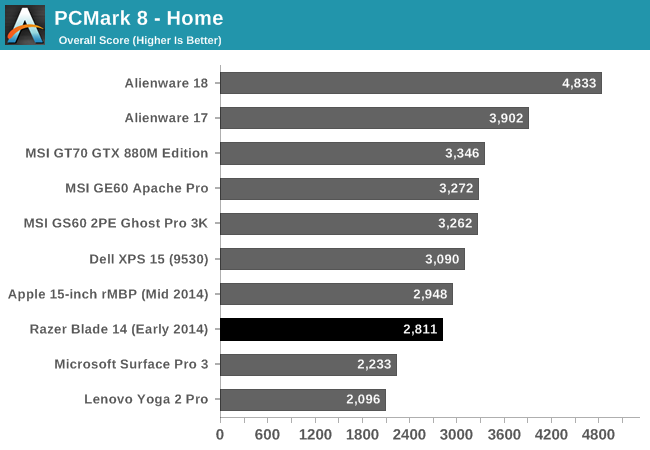
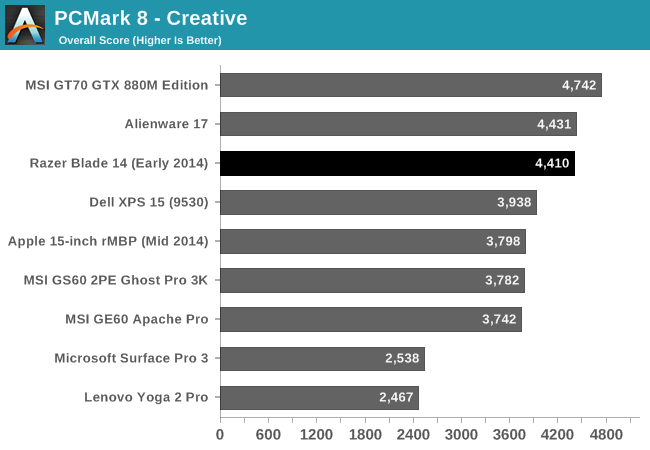

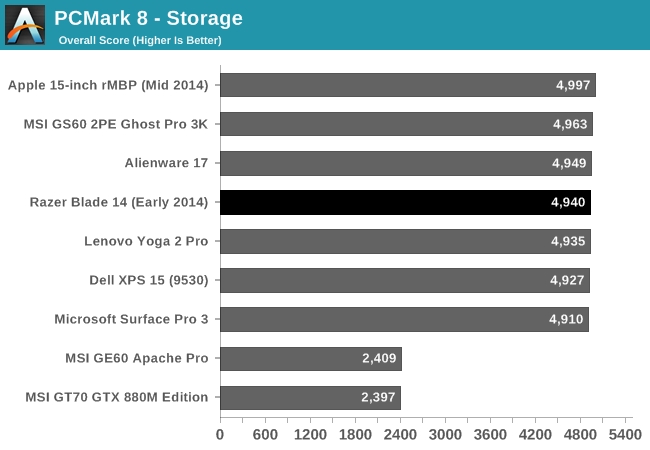
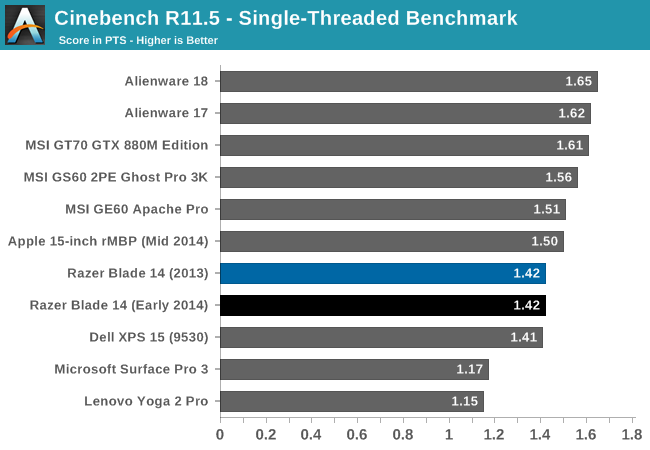
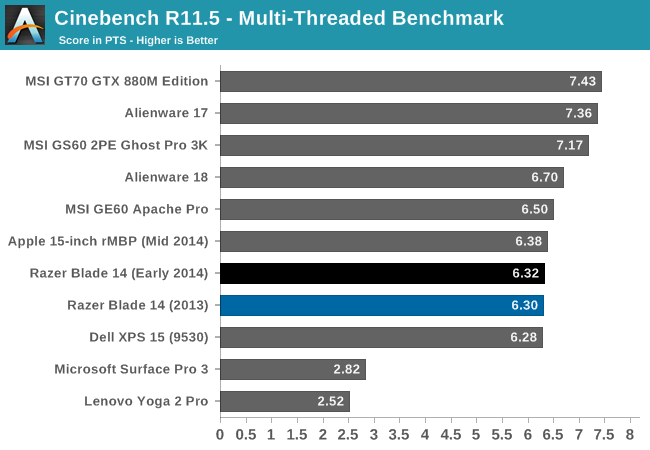
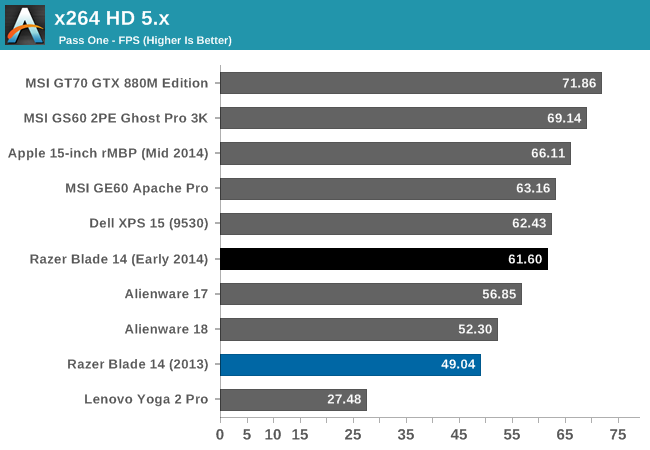
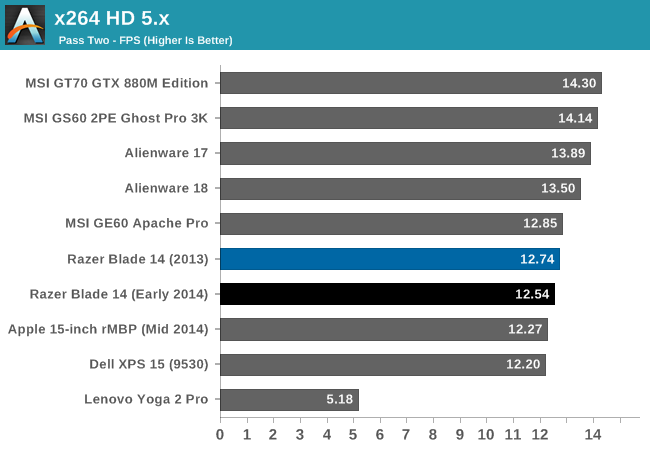
With the 37 watt CPU, the Razer Blade falls right where you would expect. Overall, there is more performance than the Ultrabook class machines such as the Yoga 2 Pro and the Surface Pro 3, but other gaming laptops with higher wattage CPUs are a bit faster. Still, for the Razer Blade’s intended use scenario, system performance is great. The M.2 SSD in the Razer Blade performs very well in the PCMark 8 Storage test, scoring very close to the rest of the SSD pack.
WiFi
The new Razer Blade has updated the WiFi card from the previous version that used a Killer Wireless-N 1202 dual-band 2x2 802.11a/b/g/n solution. The new Blade now features the Intel Dual-Band Wireless-AC 7260, which adds support for 802.11ac. This wireless card is a 2x2:2 card offering connection speeds up to 866 Mbps on an 802.11ac connection.
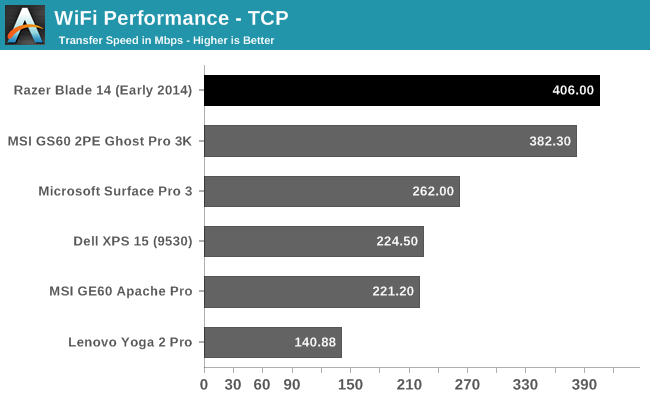
With around 400 Mbps sustained transfer speeds, the Intel wireless card does pretty well with the router close by, but in other tests Ganesh has found that the Broadcom BCM4352 card performs better, especially with some drywall between you and the router. With the Razer Blade 30’ from the router in another room, the wireless speeds dropped to around 270 Mbps, which is still a reasonable result. Still, the Blade has 802.11ac and therefore supports both 5 GHz and 2.4 GHz, so there is not too much to complain about here. The Intel card also performs the Bluetooth 4.0 functions.










69 Comments
View All Comments
lyeoh - Saturday, October 11, 2014 - link
What's the display and other IO latency? What tests did you use for your graphics ghosting test?Calista - Saturday, October 11, 2014 - link
Hi Brett!How well does the screen deal with gaming at non-native resolutions. A major advantage of high-dpi displays is obviously the fact it brings us closer to the way a CRT screens behave with fixed resolution all. With such high pixel density and a normal viewing distance of >60 cm I would expect also odd resolutions to look great in their own right.
Brett Howse - Sunday, October 12, 2014 - link
I only ran it at 1600x900 which is a perfect 2:1 interpolation, and it looked fine. Hard to say if it would be as good as a native 1600x900 panel but to my eyes, it looks good enough if you do need to run it at that resolution. Gaming at 3200x1800 was absolutely fantastic though it was an amazing experience. Everything is just so sharp.fancypr007 - Sunday, October 12, 2014 - link
What's funny is how the previous model used a 1600x900 TN panel screen and at the time the excuse Razer's CEO gave for using it vs using a superior IPS panel was; "this is a gaming laptop and we wanted to use the best screen for gaming."Now they're using a panel that for modern games, you'll never be able to push at anywhere near native resolutions with the included graphics card. Marketing doublespeak.
CaptainCupcakes - Thursday, October 30, 2014 - link
The reasoning for the new QHD+ display was to prove a point of what Razer is actually capable of. The logic behind last year's screen resolution was that if they used a screen that could not outpace their GPU, that the computer would have great performance. They answered the cry of the people with the new display.vol74 - Wednesday, October 15, 2014 - link
Best laptop I've ever owned. But Razer made one glaring oversight - they didn't provide a way to disable the trackpad. It's pretty aggravating when a stray thumb triggers it when gaming. Razer support recommended disabling it via the device manager. Unbelievable. Hey Razer, how about an option in Synapse to disable the trackpad when an external mouse is detected?HiTechObsessed - Wednesday, October 15, 2014 - link
Crazy expensive. You can get the CyberPowerPC thin-and-light with an 870m for $1100, and even has a slightly better CPU. This is ungodly expensive, for lower gaming performance.synaesthetic - Monday, October 20, 2014 - link
What's the point of that absurd resolution if the GPU can't even push games at 1920x1080 to a decent framerate? You're just going to have to play the games in 1600x900 anyway to get any kind of decent performance, so why bother with the super-high resolution panel if it's not even going to get used?The only logic I can detect behind this decision is that the resolution is exactly four times that of 1600x900 and would scale down to that resolution without interpolation.
ins1dious - Wednesday, November 5, 2014 - link
Seeing as how you compared the 2014 Blade to an rMBP on weight, build, battery etc... can you include the gaming scores for the rMBP as well? Obviously under bootcamp... curious as to how far behind the rMBP's 750M performance is